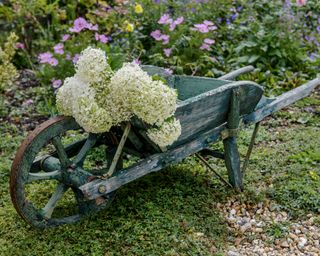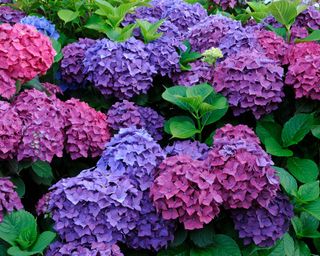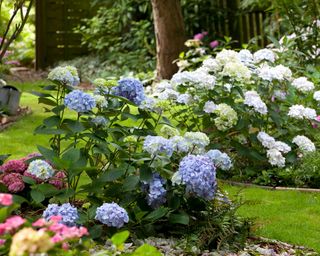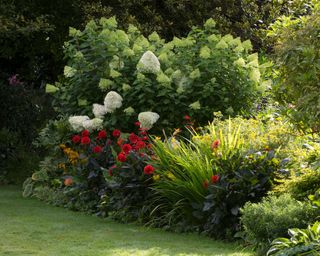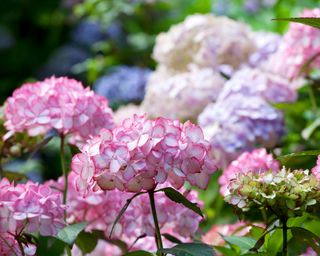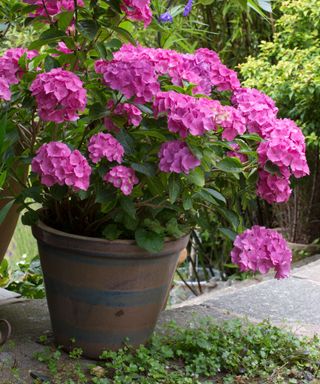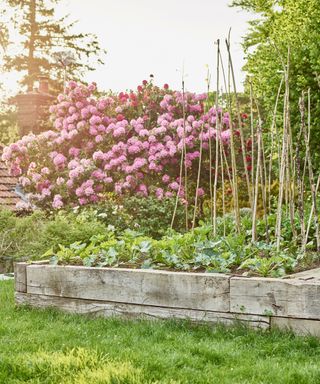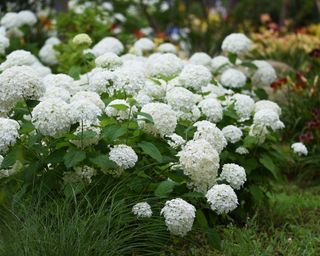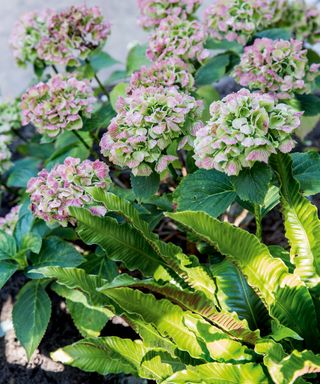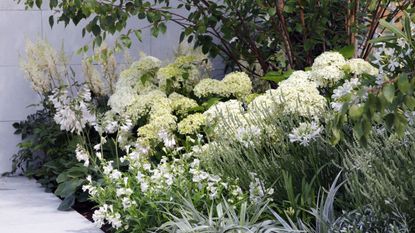
If you are wondering how to grow hydrangeas, you are not alone because these hardy shrubs that flower from mid-summer to fall have seen a real resurgence in popularity over the past decade.
Flowering shrubs are again championed and valued for their use in flower bed ideas, with hydrangeas a clear favorite for their sheer variety, reliability and large blooms ranging from cream and pink to bold blues, reds and purples.
Hydrangeas are brilliant for bringing bursts of summer color to the garden, plus they make a lovely cut flower. They are easy to grow, are tolerant of most soils, including clay, grow in sun or semi-shade, can be planted in borders or containers and require little maintenance. So what’s not to love about them?
Once you know when to plant hydrangeas and how to grow them, you will be able to enjoy the blooms of these shrubby stalwarts from July into October.
How to grow hydrangeas – the different types
The first thing to consider when learning how to grow hydrangeas is which type you want to grow, as there are two main types: shrubby and climbing.
Shrubby hydrangeas – blooming from around July – September, shrubby hydrangeas are among the flowering shrubs that are great for adding mid to late-summer color and structure to garden borders, but can also be grown in pots.
They are characterized by their large flower heads, which can either be domed or flattened in form. The domed ‘mophead’ hydrangeas consist of many tightly packed flower while the flattened ‘lacecap’ types have rings of large, pointed petals surrounding a cluster of tiny flowers.
The important thing to note about the mophead variety of hydrangea is that the colour of the flowers will vary according to the pH of your soil. The plant can have pink flowers in alkaline soil, red flowers in neutral soils and blue flowers in acid soils. It is possible to control the color of the blooms by adjusting the pH of the soi.
Climbing hydrangeas – like shrubby hydrangeas, climbing hydrangeas do not mind semi-shade so are good choices as shrubs for shade, for growing up east and north-facing walls, fences or buildings. However, there are some varieties that prefer full sun. They have delicate lacy white flowers which bloom from July – August. Hydrangea anomala petiolaris is a popular variety with a RHS Award of Garden Merit.
With over 70 species of hydrangea, there are compact varieties and ones with scented flowers or fall foliage, and even varieties that flower twice on old and new wood.
Where to grow hydrangeas
Hydrangeas grow best in well-drained soil, in a protected, dappled shady spot. They prefer sun in the morning with some shade in the afternoon.
South-facing positions are best avoided, and protect young growth from spring frosts. Most soil types are suitable, keeping in mind that the pH will change the color – less than 5.5 for blue, over 6.5 gives pink, between 5.5 and 6.5 purple.
They do not do well in dry soils, so choose a position with moist, fertile soil – to help the soil retain moisture the soil can be enhanced with garden compost or a well-rotted manure.
‘Hydrangeas like reliable moisture in the summer, so don’t plant them in a dry position. Their new shoots are frost tender, so avoid frost pockets, and if your garden experiences drought in summer, plant them in semi-shade. People seem to forget they are happy in shaded conditions and when growing hydrangeas, plant them in blazing, full sun where they look washed out and drought-stressed in summer,’ says says Matthew Pottage, curator at RHS Wisley.
As they can tolerate some shade, hydrangeas make perfect plants for woodland gardens and north-facing garden ideas.
How to plant hydrangeas
If you’re asking yourself ‘should I cut back hydrangeas in the fall’ the answer depends on the type of hydrangeas. However, in general, the best time to plant hydrangeas is in spring or fall.
- If you are planting a container-grown hydrangea, first dig a hole twice the width of the shrub’s root ball. Before planting you can enhance the soil by digging in organic matter or well rotted compost to the base of the hole to help the ground retain moisture.
- Before planting, water the hydrangea.
- Place the plant in the hole. The soil level around the plant should be the same level as the ground – to check you can lay down a bamboo cane.
- Backfill the planting hole with a mix of soil and organic matter and firm in using your heel to prevent air pockets around the roots and water well.
- Finally, mulch around the base of the plant to help it retain moisture.
- Climbing hydrangeas should be planted in the same way but will need planting at least 9 inches (22cm) from a wall, fence or house.
How to grow hydrangeas from cuttings
Like many shrubs, hydrangeas take well grown from cuttings which is a straightforward option if you’re looking for a cost-effective way for how to grow hydrangeas. Cuttings can either be taken as softwood cuttings in late spring, or semi-ripe cuttings in summer.
To take softwood cuttings:
- Softwood shrub cuttings can be taken from March to August but are best made in spring. Softwood cuttings should be made in the morning
- Select healthy non-flowering shoots of new growth and using secateurs, cut a section with 3 – 5 pairs of leaves. Seal in a plastic bag and place in a shaded place until they are ready to prepare.
- Trim off the lower leaves and reduce the cuttings to 3-4 inches (8 -10cm), cutting below a node.
- Using a pencil as a dibber, make holes in a pot filled with seed compost and insert the cuttings.
- Water the cuttings and place them in a propagator at 64-70°F / 18-21°C. Alternatively you can seal a polythene back over the top.
- Once the cuttings have rooted, harden them off and transplant into individual pots. Water, label and keep in a shaded spot to grow on.
- They can be transplanted into their final position the following spring.
You can also take semi-ripe cuttings. To do this ‘use rooting hormone on a semi-ripe cutting, place it in a pot with propagation mix, keep it warm, and in about 2 weeks, the cutting will develop roots,’ advises Lorraine Ballato, author of Success with Hydrangeas.
‘That sapling then needs to be repotted in potting soil and lightly fertilized regularly to grow it on for about 2 months before it gets planted,’ she adds.
How to grow hydrangeas in a pot
If you are growing hydrangeas in pots you can manipulate the potting compost for the color you are after – you can even pop them in the container into the garden bed to then fill gaps through summer.
Shrubby hydrangeas grow well in pots and are perfect for bringing an uplifting pop of color as a patio idea in late summer. Be sure to choose small to medium varieties for growing as container gardening ideas.
Spring and fall are the best times to plant hydrangeas into containers although it can be done at any time of year.
When planting shrubs in pots it is recommended to use loam-based soil rather than a peat-based compost as peat-based composts can dry quicker and contain less nutrients.
How to care for hydrangeas
Once planted, keep hydrangeas watered well in their first season so they don’t wilt. To keep hydrangeas blue only use rainwater. Mulching each spring with manure, compost or leaf-mold will help them thrive, and they don’t need feeding, as this will create leaf growth as opposed to flowers.
While shrubby hydrangeas flower on new season growth, climbing varieties tend to flower on previous season’s growth which means both have different pruning requirements and times for pruning. It is important to learn how to prune hydrangeas and when to prune hydrangeas to keep them looking their best and improve the plant’s vigor.
How to grow hydrangeas from seed
While you can grow hydrangeas from seed it is not recommended, ‘as it takes a few seasons to get the plant to a sizeable specimen,’ explains Lorraine Ballato.
‘Seed germination percentages are low so propagation is best done with cuttings,’ she adds.
‘Further, most of today’s hydrangeas are a cross of two or more varieties. In that case, the seed is not true to the parent. You are more likely – if it germinates – to get one of the parents, not the offspring or the desired plant. On the other hand, some extraordinarily successful “accidents” have resulted in new marketable plants,’ she adds.
Dealing with problems when growing hydrangeas
Frost damage: If new spring growth of the hydrangeas has frost damage, cut it back to just above the first undamaged pair of buds.
Hydrangea scale: This hydrangea disease shows as white, waxy blobs in summer and is best prevented by careful early inspection from spring. Tend plants to keep them as healthy as possible, encouraging predators such as ladybirds, and think carefully about what to plant with hydrangeas to make good companions. If spraying is needed use organic options in July.
Lack of flowers: This is most likely to be because pruning was done at the wrong time, so carefully check the label of the plant you buy.
Pieces bitten out of the leaves: This is a sign of vine weevils, with the white grubs also eating the roots. Check at night when they are most active, catch and squash them. You could also apply a biological control.
How do hydrangeas grow best?
With the wide range of choices and styles available, hydrangeas grow best in a number of situations. They grow beautifully en masse as informal hedging; mixed in borders; all white flowers in a classical scheme or to light up a shaded area; as well as in containers, for both town and country gardens.
‘Hydrangeas look fantastic massed in one variety for a stunning result,’ explains Roger Butler, owner of Signature Hydrangeas.
Are hydrangeas easy to grow?
Hydrangeas are easy to grow and need little attention and you are bound to find an array of options that are ideal to grace your garden and also make striking cut flowers.
For beginners, ‘Paniculata are easy to grow and more tolerant; you can’t go wrong with them,’ suggests Roger Butler.
‘Most hydrangeas are very easy, which is why they are so brilliant – but H. macrophylla and H. paniculata and all their cultivars are vey easy,’ says Matthew Pottage of RHS Wisley.


